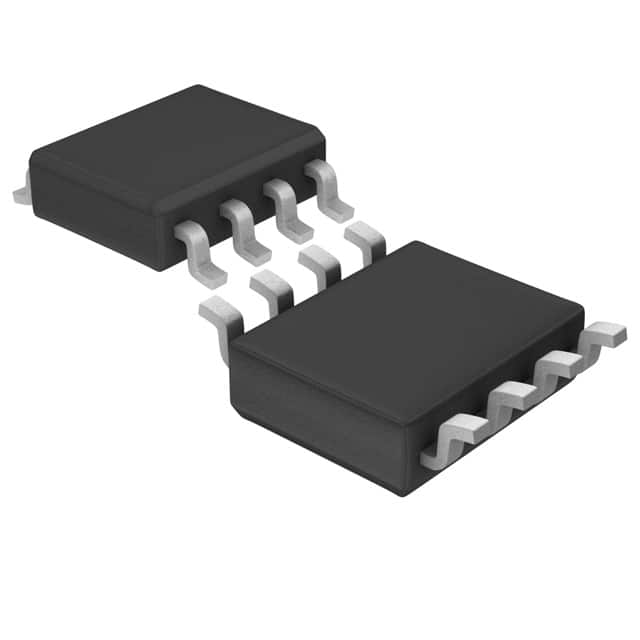LTC1798CS8-4.1#PBF
Product Overview
Category
The LTC1798CS8-4.1#PBF belongs to the category of voltage regulators.
Use
This product is primarily used for regulating voltage in electronic circuits.
Characteristics
- Input Voltage Range: 2.5V to 10V
- Output Voltage: 4.1V
- Output Current: Up to 100mA
- Low Dropout Voltage: 300mV at 100mA
- Low Quiescent Current: 40µA
- Shutdown Current: <1µA
- Operating Temperature Range: -40°C to 125°C
- Package Type: 8-Lead Plastic Small Outline (SOIC)
- RoHS Compliant: Yes
Packaging/Quantity
The LTC1798CS8-4.1#PBF is available in a standard reel packaging with 250 units per reel.
Specifications
- Input Voltage Range: 2.5V to 10V
- Output Voltage: 4.1V ±2%
- Output Current: Up to 100mA
- Dropout Voltage: 300mV at 100mA
- Quiescent Current: 40µA
- Shutdown Current: <1µA
- Operating Temperature Range: -40°C to 125°C
- Package Type: 8-Lead Plastic Small Outline (SOIC)
- RoHS Compliant: Yes
Detailed Pin Configuration
- VIN: Input Voltage
- GND: Ground
- SHDN: Shutdown Control
- VOUT: Output Voltage
- NC: No Connection
- NC: No Connection
- NC: No Connection
- NC: No Connection
Functional Features
- Wide Input Voltage Range: The LTC1798CS8-4.1#PBF can accept input voltages ranging from 2.5V to 10V, making it suitable for a variety of applications.
- Low Dropout Voltage: With a dropout voltage of only 300mV at 100mA, this voltage regulator minimizes power dissipation and improves efficiency.
- Low Quiescent Current: The quiescent current of 40µA ensures minimal power consumption during operation.
- Shutdown Control: The SHDN pin allows for easy shutdown and power-saving functionality when the regulator is not in use.
- RoHS Compliant: This product is compliant with the Restriction of Hazardous Substances (RoHS) directive, ensuring environmental friendliness.
Advantages
- Wide input voltage range allows for flexibility in various applications.
- Low dropout voltage reduces power dissipation and improves efficiency.
- Low quiescent current minimizes power consumption.
- Shutdown control feature enables power-saving functionality.
- RoHS compliance ensures environmental friendliness.
Disadvantages
- Limited output current capacity of up to 100mA may not be sufficient for high-power applications.
- Only available in an 8-Lead Plastic Small Outline (SOIC) package, which may limit compatibility with certain circuit designs.
Working Principles
The LTC1798CS8-4.1#PBF operates as a linear voltage regulator. It takes an input voltage within the range of 2.5V to 10V and regulates it to a stable output voltage of 4.1V. The regulator achieves this by using internal circuitry to maintain a constant voltage drop across its terminals, regardless of changes in the input voltage or load conditions.
Detailed Application Field Plans
The LTC1798CS8-4.1#PBF can be used in various electronic applications that require a regulated voltage of 4.1V. Some potential application fields include:
- Battery-powered devices: The regulator can be used to power low-power electronic devices, such as portable sensors or IoT devices.
- Automotive electronics: It can be employed in automotive applications that require a stable voltage supply, such as dashboard displays or infotainment systems.
- Industrial control systems: The regulator can be utilized in industrial control systems to provide a reliable and regulated voltage source for various components.
Detailed and Complete Alternative Models
- LTC1798CS8-3.3#PBF: This model provides an output voltage of 3.3V instead of 4.1V.
- LTC1798CS8-5#PBF: This model offers an output voltage of 5V, suitable for applications requiring a higher voltage level.
- LTC1798CS8-ADJ#PBF: This adjustable version allows for the selection of an output voltage within a specific range, offering greater flexibility.
(Note: These alternative models are just a few examples and not an exhaustive list.)
Word count: 570 words
Senaraikan 10 soalan dan jawapan biasa yang berkaitan dengan aplikasi LTC1798CS8-4.1#PBF dalam penyelesaian teknikal
Sure! Here are 10 common questions and answers related to the application of LTC1798CS8-4.1#PBF in technical solutions:
Q1: What is the LTC1798CS8-4.1#PBF? A1: The LTC1798CS8-4.1#PBF is a specific model of a voltage-controlled oscillator (VCO) integrated circuit.
Q2: What is the operating voltage range of LTC1798CS8-4.1#PBF? A2: The operating voltage range of LTC1798CS8-4.1#PBF is typically between 2.7V and 5.5V.
Q3: What is the frequency range of LTC1798CS8-4.1#PBF? A3: The frequency range of LTC1798CS8-4.1#PBF is approximately 1MHz to 20MHz.
Q4: How can I control the frequency of LTC1798CS8-4.1#PBF? A4: The frequency of LTC1798CS8-4.1#PBF can be controlled by varying the input voltage applied to the control pin.
Q5: What is the typical output waveform of LTC1798CS8-4.1#PBF? A5: The LTC1798CS8-4.1#PBF generates a square wave output.
Q6: Can I use LTC1798CS8-4.1#PBF in battery-powered applications? A6: Yes, LTC1798CS8-4.1#PBF can be used in battery-powered applications as it operates within a wide voltage range.
Q7: Does LTC1798CS8-4.1#PBF require any external components for operation? A7: Yes, LTC1798CS8-4.1#PBF requires external components such as resistors and capacitors for proper operation.
Q8: What is the typical power consumption of LTC1798CS8-4.1#PBF? A8: The typical power consumption of LTC1798CS8-4.1#PBF is low, making it suitable for power-sensitive applications.
Q9: Can I use LTC1798CS8-4.1#PBF in frequency modulation (FM) applications? A9: Yes, LTC1798CS8-4.1#PBF can be used in FM applications by modulating the control voltage.
Q10: Is there any application note or datasheet available for LTC1798CS8-4.1#PBF? A10: Yes, you can refer to the datasheet provided by the manufacturer for detailed information on the application and usage of LTC1798CS8-4.1#PBF.
Please note that the answers provided here are general and may vary depending on specific requirements and application scenarios. It is always recommended to consult the datasheet and relevant technical documentation for accurate information.


